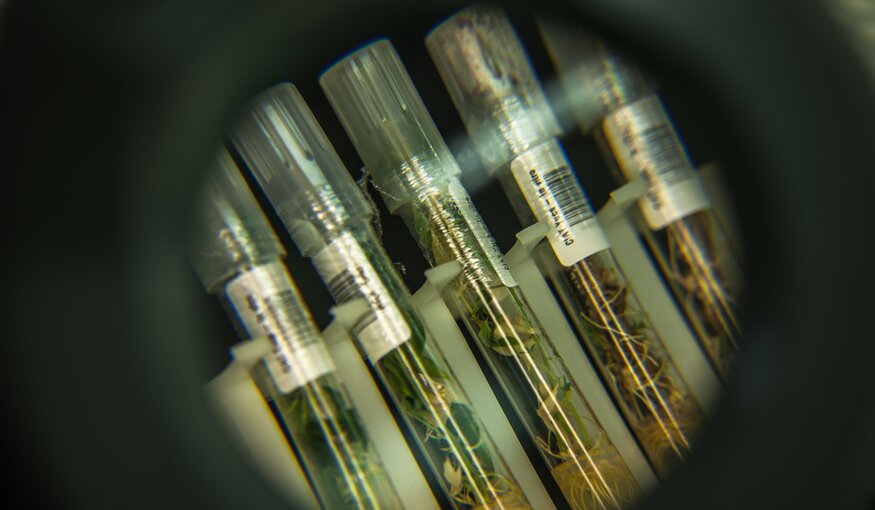Economic Benefits of Crop Diversity
 Cassava plantlets in the CIAT genebank in Cali. Barcoded labels link each plantlet to an accession database with information on the variety, landrace or wild relative and where it was collected. Some types have long since vanished from fields, but these tiny offspring keep the diversity alive. Any one of them can be grown into a full-sized crop, which could hold the key to beating a virus in Vietnam or grasshoppers in Ghana.
Cassava plantlets in the CIAT genebank in Cali. Barcoded labels link each plantlet to an accession database with information on the variety, landrace or wild relative and where it was collected. Some types have long since vanished from fields, but these tiny offspring keep the diversity alive. Any one of them can be grown into a full-sized crop, which could hold the key to beating a virus in Vietnam or grasshoppers in Ghana.23 February 2016
Crop diversity is the raw material for the development of new and improved varieties, which provide a range of important benefits to farmers and consumers.
Researchers have been assembling and managing ex situ collections of crop diversity in a systematic manner for over a century, securing traditional crop varieties and related wild species from remote, dispersed locations into genebanks. Such genebank collections provide safe, economical means to secure plant genetic resources for food and agriculture (PGRFA) and ensure that scientists have ready, convenient access to diversity they need to improve crops.
Without access to the diversity already stored in genebanks, researchers and scientists embarking on a crop improvement program would have little alternative but to create their own collections from scratch. This process would be expensive and time-consuming for an individual breeder. To illustrate, it would cost USD 6 million, or USD 120 per accession, not including the costs of building the facility or of ongoing conservation thereafter, to fully incorporate 50,000 samples of cultivated rice into a genebank collection (Hawtin et al. 2011).
In this brief, we describe a range of economic benefits that crop diversity offers with the aim to increase our understanding and awareness of the importance of conserving PGRFA. Economic valuation is one way to define and measure values that are useful to consider in making policy decisions that involve allocation of resources from a society wide perspective. In the case of crop diversity, the values can be difficult to estimate because they are usually realized only when a useful trait is identified and incorporated into crop varieties. This difficulty poses a challenge in justifying the costs of conserving crop diversity.
We focus here on the “use values”, which refer to the benefits derived from the usefulness of crop diversity in achieving a goal, e.g., improving crop productivity, improving yield stability and disease/pest resistance, enhancing nutritional content of crops, minimizing adverse environmental impacts, and rebuilding agricultural systems. Such benefits will be difficult to realize without the crop diversity already conserved in genebanks.
1. Improving crop productivity
A large body of research has documented the high rates of return from the use of PGRFA by showing how various crop varieties led to the improvement of agricultural productivity through breeding and the release of new and improved varieties. In particular, a significant share of the impact of CGIAR[1] research and breeding can plausibly be attributed to the international genebanks [Box 1].
2. Improving yield stability and disease/pest resistance
Crop diversity has contributed not only to the level of crop yields, but also to their stability [Box 2]. Yield stability is especially critical for farmers in vulnerable, marginal situations. Gollin (2006) finds declining variability of maize and wheat yields in developing countries that is strongly associated with the spread of improved varieties. Other studies put values on long-standing efforts in breeding for disease and pest resistance. More importantly, agricultural systems globally have largely avoided major crop failures, in part because more frequent turnover of varieties has brought new sources of resistance (Renkow and Byerlee 2010).
3. Enhancing nutritional content of crops
More than two billion people in the world do not get enough essential vitamins and minerals – such as vitamin A, zinc, and iron – because more nutritious foods are too expensive or simply unavailable (HarvestPlus 2014). Through biofortification, HarvestPlus and its partners have developed new varieties of staple food crops that contain higher amounts of key nutrients [Box 3]. While impact studies have not considered aggregate adoption and long run use, this type of work is likely to accelerate with the scaling up of biofortification research by CGIAR and partners (Renkow and Byerlee 2010).
4. Minimizing adverse environmental impacts
Crop genetic improvement has also resulted in increases in resource-use efficiency in farms, minimizing adverse pressures on the environment. While the early varieties of the Green Revolution were input intensive, there has been a shift towards improved varieties that require less pesticide, fertilizer, water, labor, and indeed, land [Box 4].
5. Rebuilding agricultural systems
Beyond the research programs on crop improvement, the CGIAR has also been instrumental in helping to rebuild agricultural systems in at least 47 developing countries affected by conflicts and natural disasters across Asia, Africa and Latin America, including through the restoration of crop diversity (Varma and Winslow 2005) [Box 5]. The economic (and cultural) values of such contributions have not been estimated, but are clear additional benefits beyond the contribution of crop diversity to improvement programs.
Improving crop productivity[Box 1]
- 100% of rice varieties from the International Rice Research Institute (IRRI) and 90% of rice varieties released by national programs had at least one IRRI genebank accession in their pedigrees (CGIAR 2013).
- Nearly 60% of the 411 bean varieties released since 1976 contain materials from the genebank at the International Center for Tropical Agriculture (CIAT) (Johnson et al. 2003)
- There has been an 11% yield gain from IRRI’s contribution to varietal improvement between 1985 and 2009, leading to economic benefits of USD1.46 billion per year (about USD 88 per hectare) across three major rice producers in Southeast Asia -- Philippines, Vietnam, and Indonesia (Brennan and Malabayabas 2011).
- Aggregate economic benefits accruing from the adoption of improved cassava variety, KU 50, are estimated at USD 44 million and USD 53 million in Thailand and Vietnam, and much of this would have translated into a substantial impact on poverty alleviation through the producer surpluses accruing to cassava growers (Robinson and Srinivasan 2013).
- Economic benefits from the adoption of improved potato variety, C88, are estimated at USD 350 million per year in China. C88 has also stimulated growth in the potato processing industry and has provided economic benefits to the poor estimated at USD 192 million a year (Robinson and Srinivasan 2013).
Improving Yield Stability and Disease and Pest Resistance[Box 2]
- The annual value of benefits from improved yield stability are estimated at USD 149 million for maize and USD 143 million for wheat (Gollin 2006).
- The work of the International Maize and Wheat Improvement Center (CIMMYT) on maintaining leaf rust resistance has generated USD 5.4 billion (in 1990 dollars) (Marasas et al. 2004).
- Global benefits of resistance to all types of wheat rusts are estimated between USD 600 million and USD 2 billion per year (in 2006 dollars) (Dubin and Brennan 2009).
ENHANCING NUTRITIONAL CONTENT OF CROPS[Box 3]
- A 2014 study in Zambia found significant increases in total body stores of vitamin A for groups that received biofortified orange maize (Gannon et al. 2014).
- In Mozambique, there has been an increased intake of vitamin A among young children in households receiving orange-fleshed sweet potatoes combined with extension advice on nutrition (Low et al. 2007). A follow-up study found evidence of reduced duration of diarrhea through agricultural interventions that promoted the consumption of orange-fleshed sweet potato (Jones and de Brauw 2015).
- The first zinc-rich rice variety “BRRI dhan 62”, developed from zinc-rich parental germplasm produced at IRRI and advanced by the Bangladesh Rice Research Institute with support from HarvestPlus, was released in Bangladesh in 2013 (Mallikarjuna Swamy et al. 2015).
MINIMIZING ADVERSE ENVIRONMENTAL IMPACTS[Box 4]
- Technology-driven intensification at a global level minimizes expansion of agriculture into marginal lands (Villoria et al. 2014; Byerlee et al. 2014).
- Drought-tolerant varieties released in India, the Philippines and Nepal show promising yield advantages of 0.8-1.2 tons per hectare over drought-susceptible ones (IRRI 2015).
- A meta-analysis by Klümper and Qaim (2014) covering 147 publications finds 37% reduction in chemical pesticide use and 22% increase in yields from adoption of improved crop varieties. Together, the yield gains and cost savings have resulted in a 68% increase in farm profits.
- At IRRI’s rice research farms in the Philippines, insecticide use has been reduced by 96% between 1993 and 2008 (Hamilton 2008).
- Nitrogen-fertilizer efficiency of maize in the U.S. has increased by 36% in the past 21 years due to public sector research and extension (Tilman et al. 2002).
REBUILDING AGRICULTURAL SYSTEMS[Box 5]
- The International Potato Center (CIP) has been working for many years with the communities of the Parque de la Papa in Peru to restore lost ancestral potato varieties (CIP 2012).
- The Syrian genebank of the International Center for Agricultural Research in the Dry Areas (ICARDA) retrieved part of its seed collection in 2015 that has been safely duplicated and stored in the Svalbard Seed Vault in Norway, to fulfill requests for crop diversity from breeders, researchers and farmers around the world (Conlon 2015).
References
Brennan JP, Malabayabas A (2011) International Rice Research Institute’s contribution to rice varietal yield improvement in South-East Asia. Australian Centre for International Agricultural Research, Canberra, Australia
Byerlee D, Stevenson J, Villoria N (2014) Does intensification slow crop land expansion or encourage deforestation? Glob Food Secur 3:92–98. doi: 10.1016/j.gfs.2014.04.001
CGIAR (2013) Genebanks: investing in biodiversity for future generations. CGIAR Consortium, Partnership and Stakeholder Engagement
CIP (2012) New advances in repatriation and conservation of native potatoes. International Potato Center (CIP)
Conlon K (2015) Syria’s civil war prompts first “Doomsday Vault” withdrawal. CNN
Dubin HJ, Brennan JP (2009) Combating stem and leaf rust of wheat: Historical perspective, impacts, and lessons learned. International Food Policy Research Institute
Gannon B, Kaliwile C, Arscott SA, et al (2014) Biofortified orange maize is as efficacious as a vitamin A supplement in Zambian children even in the presence of high liver reserves of vitamin A: a community-based, randomized placebo-controlled trial. Am J Clin Nutr. doi: 10.3945/ajcn.114.087379
Gollin D (2006) Impacts of International Research on Intertemporal Yield Stability in Wheat and Maize: An Economic Assessment. CIMMYT, Mexico
Hamilton HS (2008) The pesticide paradox. International Rice Research Institute (IRRI)
HarvestPlus (2014) Going Global: 2014 Annual Report.
Hawtin G, Shands H, MacNeil G (2011) The cost to the CGIAR centers of maintaining and distributing germplasm. Consortium Board of Trustees
IRRI (2015) Climate-change ready rice. irri.org/our-work/research/better-rice-varieties/climate-change-ready-rice.
[1] The Consultative Group on International Agricultural Research (CGIAR) is a strategic alliance of countries, international and regional organizations, and private foundations supporting 15 international agricultural research centers.
Categories: Cassava, Maize, Wheat, Food Security
